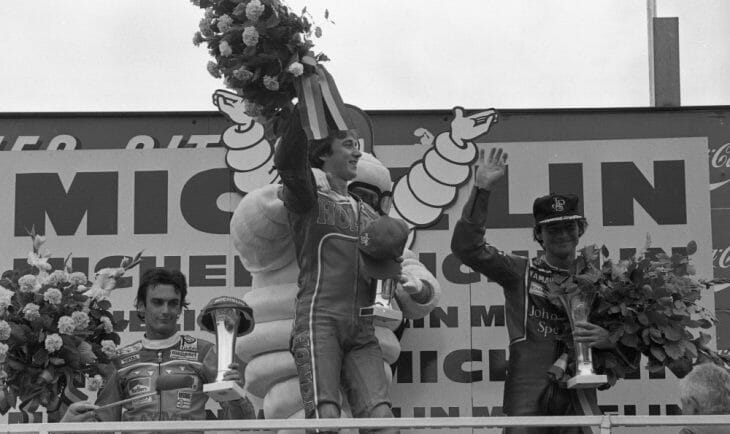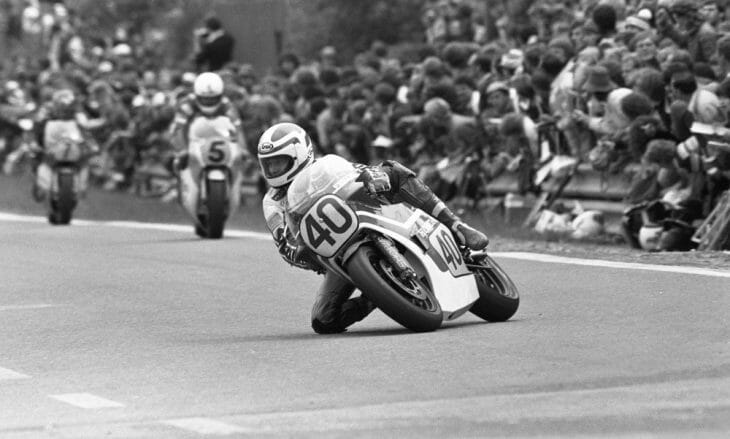Larry Lawrence | April 26, 2017

Franco Uncini looks none to thrilled with Freddie Spencer’s first GP victory, while Barry Sheene looks fine with it. (Henny Ray Abrams photo)
July 4, 1982 is a date that will long live in the storied history of Grand Prix motorcycle racing. That day at the fabled Spa-Francorchamps racing circuit in Belgium, Freddie Spencer scored his first 500cc Grand Prix victory. Not only was it a breakthrough day for Spencer, in was perhaps even more significant for Honda. It marked the first premier class Grand Prix for the manufacturer since 1967.
Of course, Honda was absent from the championship for most of those 15 years, nevertheless Spencer victory at Spa put the largest motorcycle maker in the world back atop the most prestigious class in all of motorcycle racing and with Spencer’s inaugural win, the order of the sport felt somehow restored.
Suzuki was very strong during this period. Italian Marco Lucchinelli and young American Randy Mamola finished first and second in the 500cc Grand Prix World Championship in 1981, both riding the legendary Suzuki RG500. Kenny Roberts was still generally considered the best road racer in the world, but after scoring three consecutive world championships, KR suffered a reversal of fortune and suffered a season of odd mechanical gremlins on the new square-four Yamaha YZR500 and finished third in the championship.
In 1982 Suzuki’s RG was probably still at the top of the heap, but the defending winning maker would now face a new V-Four from Yamaha. Roberts was looking to earn back the title and he was joined on a other Yamaha factory bikes with riders Graeme Crosby and Barry Sheene (mostly riding the previous generation square-four Yamaha). Honda finally threw in the towel on its NR500 four-stroke and instead came into 1982 with a revolutionary V-3 two-stroke Honda NS500. Big H came loaded by hiring defending world champ Lucchinelli, veteran Takazumi Katayama, as well as the promising 20-year-old American star Freddie Spencer to ride the lightweight NS. Kawasaki was still limping along the ill-fated KR500 with Kork Ballington.
Spencer, who had qualified for a single GP in both 1980 and ’81, but had yet to finish a race as he came into the 1982 season on the new Honda V-3.
Things started well for Spencer in the opening round in Argentina. He finished third, just a second behind winner Roberts and a half-second behind second-place Sheene. It was a great debut for both Spencer and the new Honda GP machine.
Spencer was running second in Austria, round two, when his machine expired.
All of the factory teams withdrew from the French round in Nogaro, after the facility was found to be subpar.
Then Spencer scored his first pole at the Spanish Grand Prix in Jarama. He looked set to earn his first GP win, but six laps in while leading with two second in hand over Roberts and Sheene, an ignition wire on Spencer’s Honda snapped causing him to DNF.
“I couldn’t believe it at first,” Spencer told Cycle News about leading and pulling away at Jarama. “I figured I would see how fast those guys behind me could go, although I certainly could have gone faster if they’d got any closer.”

Freddie Spencer leading the Belgian Grand Prix in a front of a massive crowd. (Henny Ray Abrams photo)
In Spain the point had been made. Spencer and the NS500 were for real and a victory seemed imminent.
Spencer scored his best GP result to date at the Nations Grand Prix in Misano, runner-up to Suzuki’s Franco Uncini. At the race Uncini tied Roberts (who finished fourth) atop the series standings. Spencer stood fifth.
At Assen Spencer suffered bad luck when he crashed just before the race was red flagged. On the restart a broken steering damper bolt ended his day.
But a week later the disappointment of the Dutch TT was long forgotten when Spencer broke through to win the Belgian Grand Prix.
Spencer qualified his Honda second, just behind the time of Jack Middelburg. In the race Middelburg led early, but Crosby and then Roberts shared time at P1. Just prior to the halfway point Spencer moved up and took over the lead from Roberts. At that point, the young Honda ace pulled clear of the field. In the end his margin of victory was four seconds, but that was deceiving since he backed off on the final lap.
Spencer was jubilant after scoring his premier 500cc Grand Prix victory.
“This is July 4th, America’s birthday and there’s no better way for me to celebrate it than this,” Spencer beamed. “Today was the first time I felt like I was riding the 500 well.”
Sheene finished second, but even he seemed happy with the result, having been an early advocate for Spencer. “I’m pleased for Freddie. He’s a super bloke.”
Spencer’s mechanic and mentor Erv Kanemoto had a feeling Spa was going to be the place where Spencer broke through. “I thought things would come together for us at this race,” he said. “We had a plan to follow this year and I knew that Freddie liked this track and thought he could win it.”
Not only was it an historic victory in terms of Honda’s first win since 1967, Spencer became the youngest rider at that point to win a premier class Grand Prix. He finished out his first full season ranked third in the championship and took a second victory at Mugello.
Spencer would go on to earn 27-career Grand Prix wins, but he would always remember the first victory at the Belgium track of Spa, a circuit he would go on to call his all-time favorite – and for good reason.